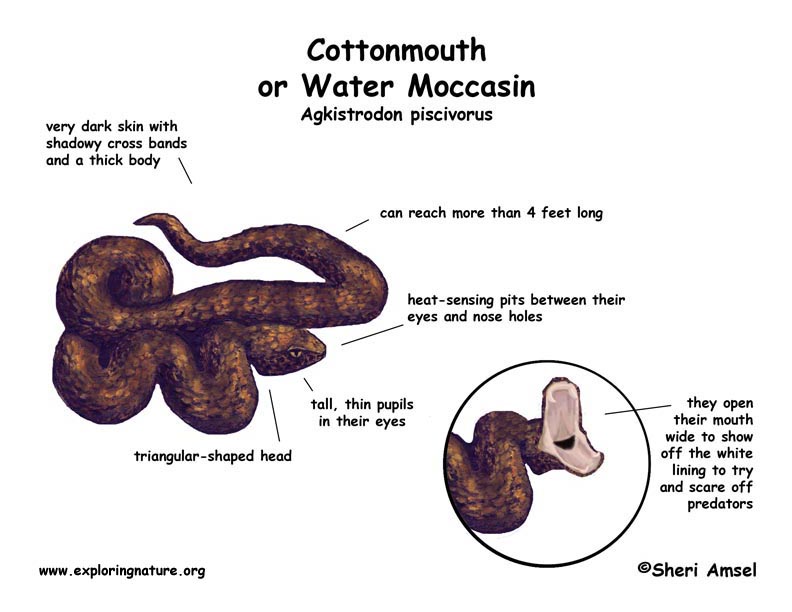

They are found in the Southeastern U.S.
They live in wet areas and on the edges of bodies of water – swamps, marshes, ponds, lakes, streams, and even drainage ditches. They rest coiled, sunning themselves on rocks, logs, and stumps.
They can reach more than 4 feet long. They have a triangular-shaped head that is wider than their neck. They have tall, thin pupils in their eyes. As pit vipers, they have heat-sensing pits between their eyes and nose holes (nostrils). They have very dark skin with shadowy cross bands and a thick body.
Their name – cottonmouth – comes from their behavior of opening the mouth to show the white lining to scare off predators. They will also shake their tail like a rattlesnake, but they have no rattle. They do not move off as readily as other snakes do when threatened. When they bite, they hold on and inject venom.
They eat insects, fish, amphibians, other snakes, young alligators and turtles, and even birds.
Females are pregnant for about 4 months and have up to a dozen live young (oviviparous). They can be almost a foot long at birth. Their coloring is more like a copperhead, with a brown pattern against a light background and a yellow tip of the tail. It is believed that they use this yellow tip to shake and attack prey that they can then bite and eat.
Kingdom: Animalia
Phylum: Chordata
Subphylum: Vertebrata
Class: Reptilia
Order: Squamata
Suborder: Serpentes
Family: Viperidae
Genus: Agkistrodon
Species: A. piscivorus
When you research information you must cite the reference. Citing for websites is different from citing from books, magazines and periodicals. The style of citing shown here is from the MLA Style Citations (Modern Language Association).
When citing a WEBSITE the general format is as follows.
Author Last Name, First Name(s). "Title: Subtitle of Part of Web Page, if appropriate." Title: Subtitle: Section of Page if appropriate. Sponsoring/Publishing Agency, If Given. Additional significant descriptive information. Date of Electronic Publication or other Date, such as Last Updated. Day Month Year of access < URL >.
Amsel, Sheri. "Snake (Cottonmouth or Water Moccasin)" Exploring Nature Educational Resource ©2005-2024. December 13, 2024
< http://exploringnature.org/db/view/532 >

